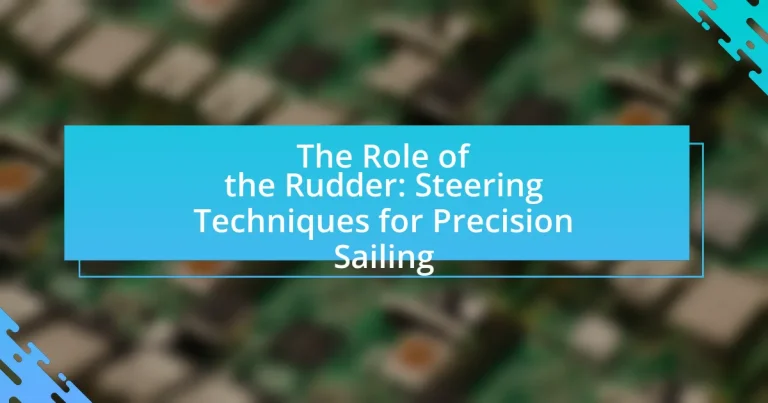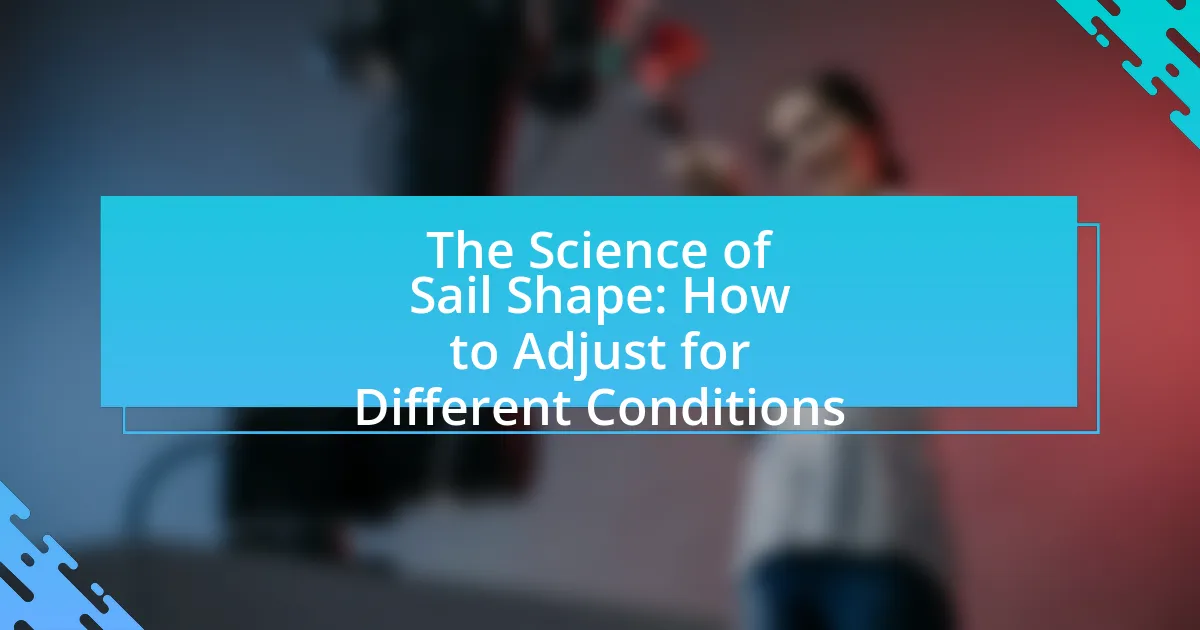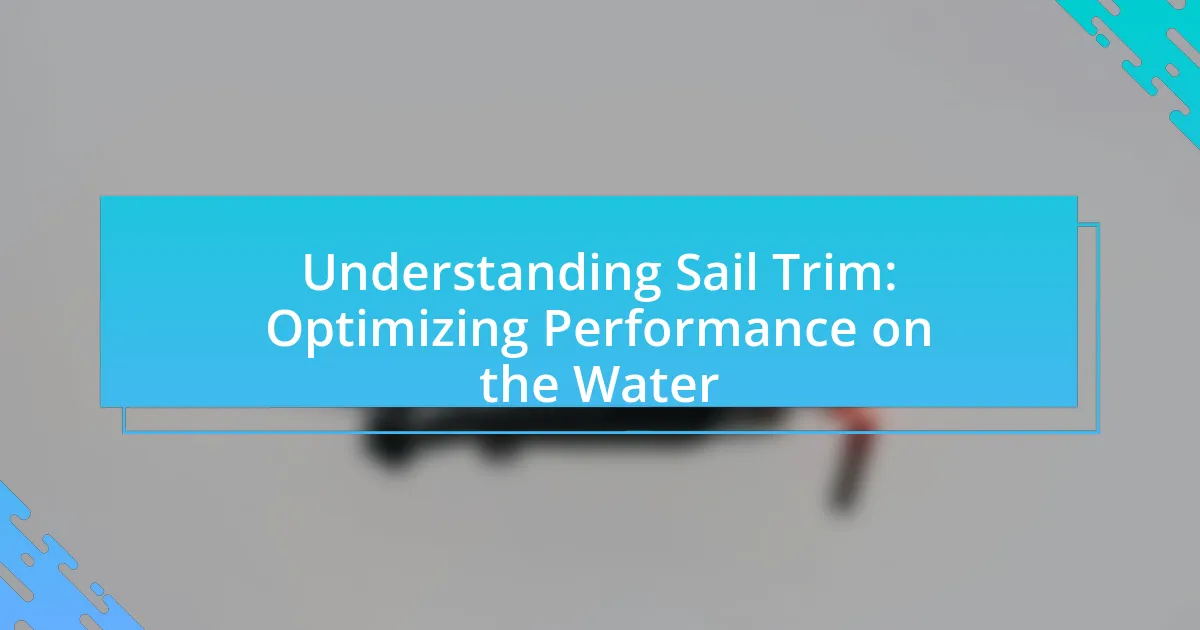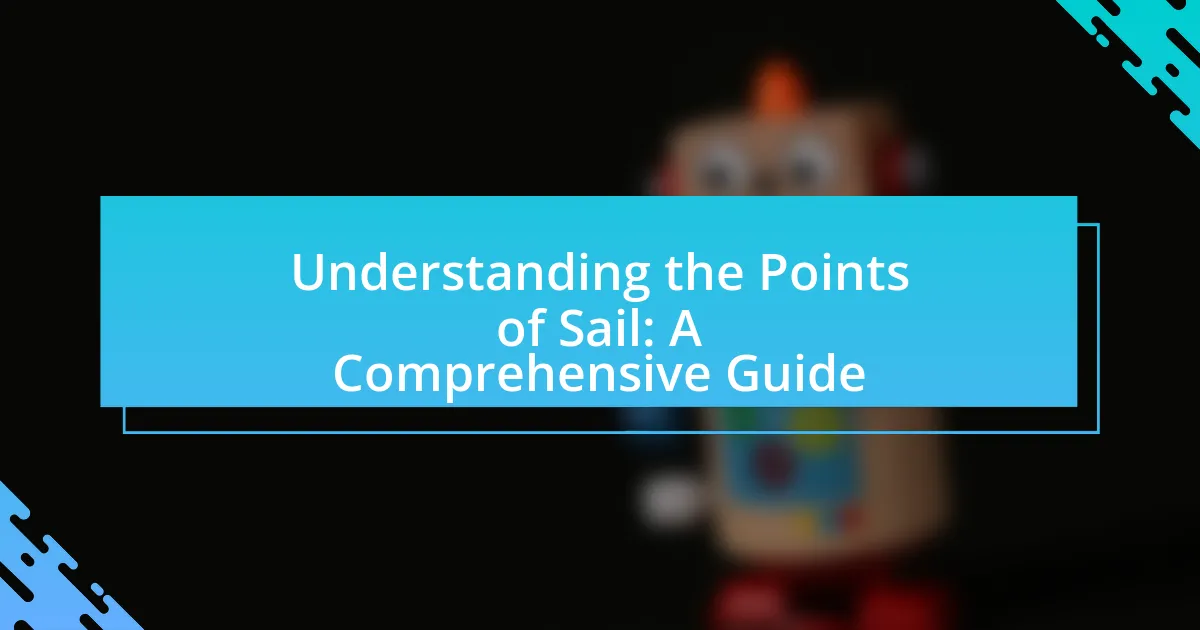The rudder is a vital component in sailing, primarily responsible for steering the vessel by redirecting water flow to control direction. This article explores the mechanics of rudder operation, the influence of water flow on performance, and the importance of precision steering for effective navigation. It also examines various rudder types, their designs, and materials, highlighting how these factors impact maneuverability and durability. Additionally, the article addresses common challenges in precision steering and offers practical tips and strategies to enhance rudder control, ensuring safer and more efficient sailing experiences.
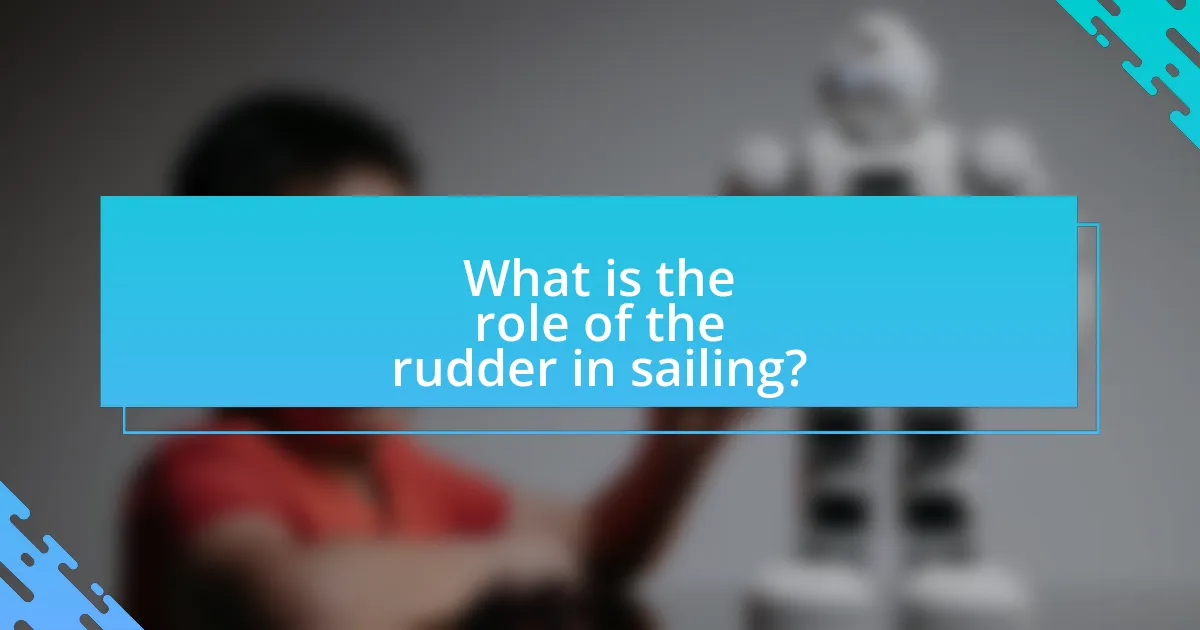
What is the role of the rudder in sailing?
The rudder in sailing is a critical component used for steering the vessel. It functions by redirecting water flow, which allows the sailor to control the direction of the boat. When the rudder is turned, it creates a difference in water pressure on either side, resulting in a turning motion. This principle is supported by hydrodynamic theory, which explains how fluid dynamics govern the movement of objects through water. The effectiveness of the rudder is essential for navigation and maneuverability, particularly in varying wind and sea conditions.
How does the rudder influence a sailboat’s direction?
The rudder influences a sailboat’s direction by redirecting water flow, which creates lateral forces that turn the vessel. When the helmsman moves the rudder, it alters the angle at which water flows past the hull, resulting in a change in direction. This principle is based on hydrodynamics, where the rudder acts as a foil, generating lift perpendicular to the water flow. The effectiveness of the rudder is also dependent on the boat’s speed and the angle of attack; at higher speeds, the rudder can exert greater control.
What are the basic mechanics of rudder operation?
The basic mechanics of rudder operation involve the rudder’s deflection in the water to create a force that alters the vessel’s direction. When a sailor turns the helm, the rudder pivots, changing its angle relative to the water flow. This angle generates hydrodynamic lift, which pushes the stern of the vessel in the opposite direction of the rudder’s turn, effectively steering the boat. The effectiveness of this operation is influenced by factors such as the vessel’s speed, the rudder’s size and shape, and the water’s flow characteristics. For instance, a larger rudder can produce more lift, enhancing maneuverability, especially at lower speeds.
How does water flow affect rudder performance?
Water flow significantly affects rudder performance by influencing the lift and drag forces acting on the rudder. When water flows smoothly over the rudder’s surface, it generates optimal lift, allowing for effective steering and maneuverability. Conversely, turbulent or disrupted water flow can lead to increased drag and reduced lift, impairing the rudder’s ability to steer the vessel efficiently. Studies have shown that maintaining laminar flow over the rudder enhances its effectiveness, as evidenced by the fact that vessels with well-designed rudders experience better handling and responsiveness in various sailing conditions.
Why is precision steering important in sailing?
Precision steering is important in sailing because it directly influences the vessel’s ability to navigate accurately and efficiently. Accurate steering allows sailors to maintain optimal course headings, which is crucial for effective wind utilization and minimizing drift. Studies show that precise steering can enhance a boat’s speed and maneuverability, particularly in competitive sailing scenarios where even slight deviations can result in significant time losses. Furthermore, precision steering aids in avoiding obstacles and ensuring safe passage through narrow channels or crowded waters, thereby reducing the risk of collisions.
What are the consequences of poor steering techniques?
Poor steering techniques can lead to a loss of control over the vessel, resulting in dangerous situations such as capsizing or collisions. When steering is executed improperly, the boat may not respond accurately to the rudder’s commands, causing it to veer off course. This lack of precision can increase the risk of accidents, particularly in crowded or challenging waters. Additionally, poor steering can lead to inefficient sailing, wasting time and fuel, and potentially damaging the vessel or its equipment. Studies have shown that effective steering techniques are crucial for maintaining safety and performance in sailing, emphasizing the importance of proper training and practice.
How does precision steering enhance sailing efficiency?
Precision steering enhances sailing efficiency by allowing for more accurate control of the vessel’s direction and speed. This level of control minimizes unnecessary maneuvers and optimizes the boat’s trajectory relative to wind and water conditions. For instance, studies have shown that vessels employing precision steering techniques can achieve up to 15% better speed and fuel efficiency compared to those using traditional steering methods. This improvement is largely due to the ability to maintain optimal angles to the wind, reducing drag and improving overall performance.

What are the different types of rudders used in sailing?
The different types of rudders used in sailing include spade rudders, skeg-mounted rudders, and balanced rudders. Spade rudders are typically found on modern racing yachts and are characterized by their lightweight and efficient design, allowing for quick response and maneuverability. Skeg-mounted rudders are attached to a skeg, providing additional protection and stability, making them common on cruising boats. Balanced rudders feature a design that allows a portion of the rudder to be forward of the pivot point, reducing the effort needed to steer and enhancing control. These rudder types are essential for effective steering and maneuverability in various sailing conditions.
How do various rudder designs impact steering?
Various rudder designs significantly impact steering by influencing maneuverability, responsiveness, and stability of a vessel. For instance, a larger rudder surface area enhances turning ability and provides better control at lower speeds, while a smaller rudder may improve speed but reduce responsiveness. Additionally, the shape of the rudder, such as a skeg-mounted rudder versus a spade rudder, affects how quickly a boat can change direction; spade rudders typically offer quicker response times due to their reduced drag. Studies have shown that different designs can lead to variations in steering effectiveness, with some designs providing up to 30% better maneuverability in specific conditions.
What are the characteristics of a balanced rudder?
A balanced rudder is characterized by its design that minimizes the force required to turn the vessel while maintaining effective steering control. This type of rudder typically has a portion of its area positioned forward of the rudder stock, which helps to create a lifting effect that counteracts the turning moment generated by the hull’s movement through the water. Additionally, a balanced rudder allows for improved responsiveness and reduces the tendency for the vessel to heel excessively during maneuvers. The effectiveness of a balanced rudder is supported by its ability to enhance maneuverability, particularly in various sailing conditions, making it a preferred choice in precision sailing.
How does a spade rudder differ from a skeg-mounted rudder?
A spade rudder is a type of rudder that is not attached to the hull by a skeg, allowing for greater maneuverability and responsiveness, while a skeg-mounted rudder is supported by a skeg, which provides stability but can limit agility. The spade rudder’s design allows it to pivot freely, making it more effective in quick turns and during high-speed sailing, whereas the skeg-mounted rudder offers better protection from damage and can enhance tracking in rough waters. This distinction is crucial for sailors to consider when choosing a rudder type based on their sailing style and conditions.
What materials are commonly used for rudder construction?
Common materials used for rudder construction include fiberglass, aluminum, stainless steel, and wood. Fiberglass is favored for its lightweight and corrosion-resistant properties, making it ideal for various marine environments. Aluminum offers strength and durability, while stainless steel is often used for its resistance to rust and structural integrity. Wood, though less common in modern designs, is still utilized for traditional boats due to its aesthetic appeal and ease of shaping. These materials are selected based on their performance characteristics and suitability for specific sailing conditions.
How do material choices affect rudder durability and performance?
Material choices significantly impact rudder durability and performance by influencing strength, weight, and resistance to environmental factors. For instance, materials like fiberglass and carbon fiber offer high strength-to-weight ratios, enhancing performance through improved maneuverability and responsiveness. In contrast, metals such as aluminum provide durability but can add weight, potentially affecting speed and handling. Additionally, composite materials resist corrosion and fatigue better than traditional materials, leading to longer service life and consistent performance under varying conditions. Studies have shown that rudders made from advanced composites can withstand harsher marine environments, thus maintaining their structural integrity and performance over time.
What innovations in rudder materials have emerged recently?
Recent innovations in rudder materials include the development of advanced composites, such as carbon fiber reinforced polymers, which offer enhanced strength-to-weight ratios and improved durability. These materials have been increasingly adopted in high-performance sailing vessels, allowing for greater maneuverability and responsiveness. Additionally, the use of bio-inspired designs and materials, such as those mimicking marine organisms, has emerged, contributing to reduced drag and increased efficiency in water. These advancements are supported by research indicating that composite materials can significantly outperform traditional metals in terms of performance and longevity in marine environments.
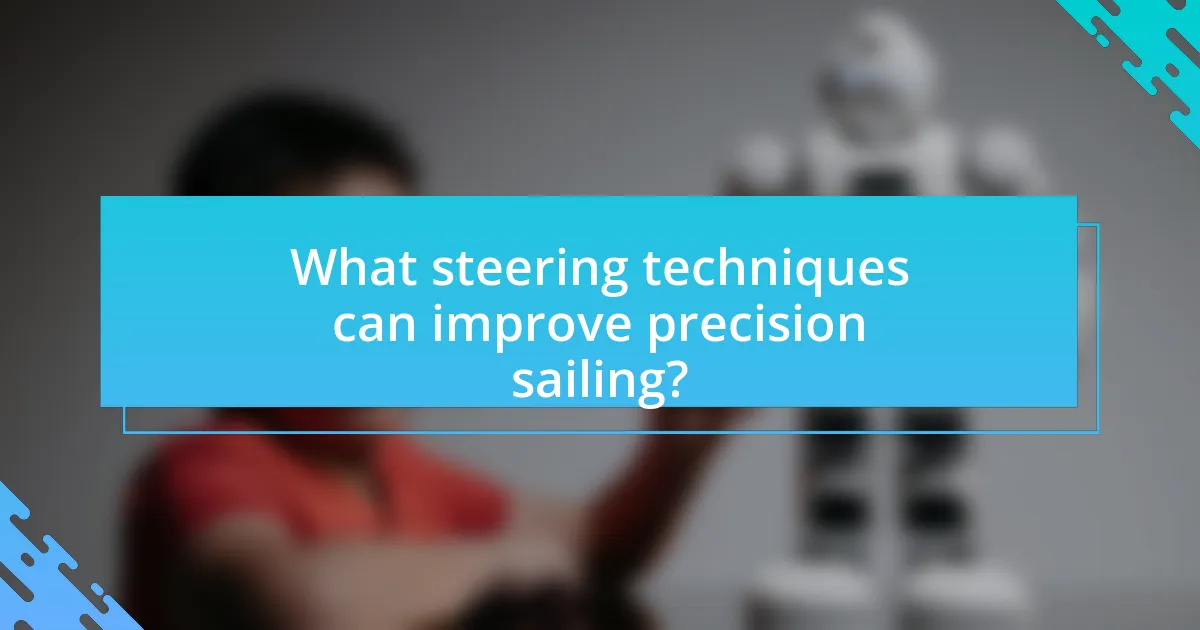
What steering techniques can improve precision sailing?
To improve precision sailing, techniques such as fine-tuning the rudder angle, utilizing small adjustments, and maintaining a steady course are essential. Fine-tuning the rudder angle allows for more accurate control of the boat’s direction, which is crucial in varying wind conditions. Small adjustments help in responding to shifts in wind and water currents without oversteering, which can lead to loss of speed and control. Maintaining a steady course ensures that the boat remains on the intended path, reducing the need for constant corrections. These techniques are supported by sailing practices that emphasize the importance of subtle steering inputs for optimal performance and maneuverability.
How can sailors effectively use the rudder for maneuvering?
Sailors can effectively use the rudder for maneuvering by applying precise steering techniques that involve adjusting the rudder angle in response to wind and water conditions. By turning the rudder to the desired angle, sailors can control the boat’s direction, allowing for sharp turns or gradual changes in course. For instance, when a sailor wants to turn left, they should move the rudder left, which causes the boat to pivot around its center of gravity. This technique is essential for navigating tight spaces or avoiding obstacles. Additionally, understanding the relationship between the rudder and the boat’s speed enhances maneuverability; at higher speeds, smaller rudder adjustments yield more significant directional changes. This principle is supported by the fact that effective rudder use is critical for maintaining control during various sailing scenarios, such as tacking or jibing, where precise maneuvering is necessary to optimize performance and safety.
What are the best practices for rudder control in various wind conditions?
The best practices for rudder control in various wind conditions include adjusting the rudder angle based on wind strength and direction to maintain optimal steering and stability. In light winds, a gentle touch on the rudder is essential to avoid oversteering, which can lead to loss of speed; small, gradual adjustments help keep the boat on course. In moderate winds, a more assertive rudder input is necessary to counteract the increased force on the sails, ensuring the boat remains balanced and responsive. In strong winds, it is crucial to reduce rudder movement to prevent excessive heeling and potential broaching; using the sails to balance the boat can minimize the need for drastic rudder adjustments. These practices are supported by sailing techniques that emphasize the importance of maintaining a steady course and minimizing drag, which is critical for effective maneuvering in varying wind conditions.
How does the angle of attack influence steering precision?
The angle of attack significantly influences steering precision by affecting the lift and drag forces acting on the rudder. When the angle of attack is optimized, the rudder generates maximum lift, allowing for more responsive and accurate steering. Conversely, an improper angle can lead to increased drag and reduced effectiveness, resulting in sluggish or imprecise steering responses. Studies in fluid dynamics demonstrate that a rudder’s performance is directly correlated with its angle of attack, highlighting that small adjustments can lead to substantial changes in steering control and vessel maneuverability.
What role does feedback play in steering techniques?
Feedback is crucial in steering techniques as it provides real-time information about the vessel’s performance and response to steering inputs. This information allows sailors to make immediate adjustments to their steering actions, enhancing precision and control. For instance, effective feedback mechanisms, such as visual cues from the water’s surface or instruments indicating the boat’s heading, enable sailors to fine-tune their rudder movements, ensuring optimal navigation and maneuverability. Studies in marine navigation emphasize that timely feedback significantly improves decision-making and reduces the likelihood of errors, thereby reinforcing the importance of feedback in achieving successful steering outcomes.
How can sailors develop a better feel for their rudder’s response?
Sailors can develop a better feel for their rudder’s response by practicing various steering techniques and becoming attuned to the boat’s behavior in different conditions. Engaging in exercises such as tacking and gybing allows sailors to experience how the rudder reacts to changes in wind and sail trim, enhancing their sensitivity to its feedback. Additionally, maintaining a consistent speed and course while making small adjustments to the rudder helps sailors recognize the immediate effects of their inputs. Research indicates that experienced sailors often rely on muscle memory and instinct, which are honed through repetitive practice and observation of the boat’s performance in diverse scenarios. This hands-on experience is crucial for developing an intuitive understanding of the rudder’s dynamics.
What tools can assist in providing feedback during sailing?
Tools that can assist in providing feedback during sailing include electronic instruments, visual aids, and manual devices. Electronic instruments such as GPS, wind speed indicators, and depth sounders provide real-time data on the boat’s position, wind conditions, and water depth, allowing sailors to make informed decisions. Visual aids like compasses and charts help sailors understand their course and navigate effectively. Manual devices, including tiller extensions and feedback systems, enable sailors to feel the boat’s response to steering inputs, enhancing their ability to control the vessel. These tools collectively improve situational awareness and decision-making during sailing, contributing to safer and more precise navigation.
What are common challenges faced in precision steering?
Common challenges faced in precision steering include maintaining accurate control, managing environmental factors, and ensuring responsiveness of the steering system. Accurate control is often hindered by the vessel’s speed and the rudder’s effectiveness, which can vary based on design and conditions. Environmental factors such as wind, currents, and waves can significantly impact steering precision, making it difficult to maintain a desired course. Additionally, the responsiveness of the steering system can be affected by mechanical issues or delays in feedback, leading to difficulties in executing precise maneuvers. These challenges necessitate skilled handling and a thorough understanding of the vessel’s dynamics to achieve effective precision steering.
How can sailors troubleshoot steering issues effectively?
Sailors can troubleshoot steering issues effectively by systematically checking the rudder, steering gear, and associated components for any signs of damage or malfunction. First, they should inspect the rudder for any physical obstructions or damage that could impede its movement. Next, they should examine the steering gear, including cables and pulleys, for wear or breakage. Additionally, verifying the fluid levels in hydraulic systems is crucial, as low fluid can lead to steering failure. Regular maintenance and pre-sailing checks can prevent many steering issues, as documented in marine safety guidelines, which emphasize the importance of routine inspections to ensure all steering components are functioning correctly.
What strategies can be employed to overcome steering difficulties?
To overcome steering difficulties in precision sailing, sailors can employ strategies such as adjusting sail trim, using the rudder effectively, and maintaining proper weight distribution. Adjusting sail trim optimizes the balance of the boat, allowing for better control and responsiveness to wind changes. Effective rudder use involves making small, precise movements to steer the boat without overcorrecting, which can lead to instability. Maintaining proper weight distribution ensures that the boat remains balanced, enhancing steering performance. These strategies are supported by sailing principles that emphasize the importance of balance and control for effective navigation.
What practical tips can enhance rudder steering techniques?
To enhance rudder steering techniques, sailors should focus on maintaining a steady hand on the tiller and making smooth, gradual adjustments. This approach allows for better control and responsiveness of the vessel. Additionally, understanding the relationship between sail trim and rudder position is crucial; properly trimmed sails reduce the need for excessive rudder input, leading to more efficient steering. Research indicates that optimal rudder use can improve maneuverability and reduce drag, enhancing overall sailing performance.












